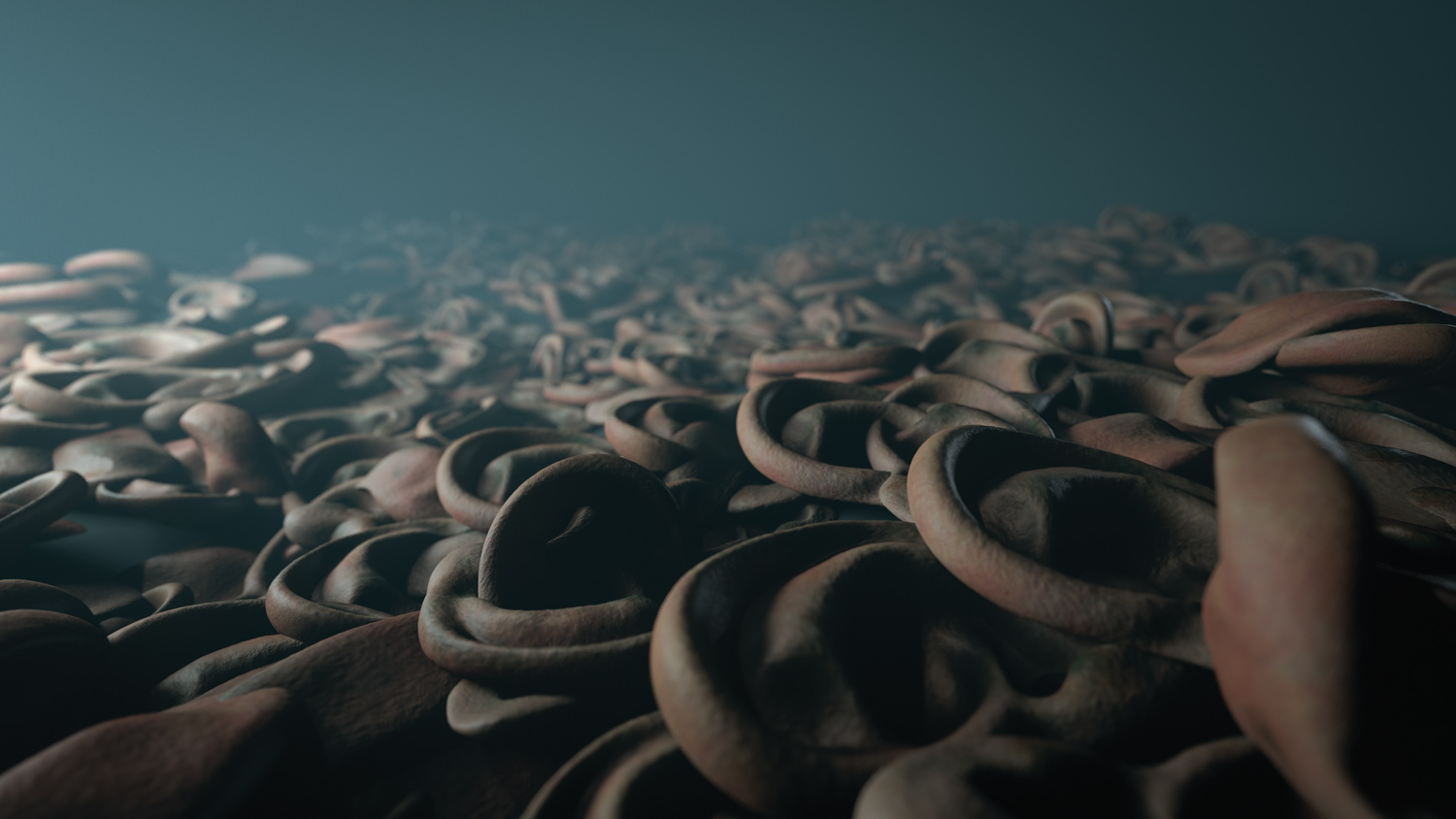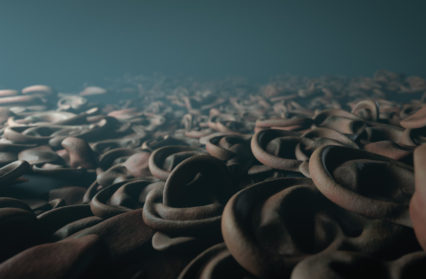Dylan Huw visits Dyfodiaith: Singing to an unknown future, the Wrexham-based artist Paul Eastwood’s first solo exhibition in Cardiff.
It deepens and expands upon the artist’s long-term interests in both the limitations and endless possibilities of linguistic communication and in elaborately imagined future worlds, its title functioning both as a portmanteau meaning “future language” or “future to come” and a homonym of the Welsh word for “dialect.” The works included are rich with such double and triple meanings, hidden symbolisms and subtle codes.
Though language is his major theme in Dyfodiaith, Eastwood’s terrain is that of the untranslatable. The exhibition consists of a video work, ‘Iaith Bwystnon’ (2019), in the Chapter Gallery’s larger space, and a sound piece, ‘Tafod Dadweirlled’ (2018) in an adjoining room. The artist assembled a team of esteemed linguists and writers to create Dyfodiaith’s distinctive language, one which is at once for the future and of the past, a mixture of Welsh and numerous other Celtic tongues, both surviving and dead. If a half-sung, half-monologued video essay in an invented language, set in an unrecognisable time and place, equally of the distant future and the ancient past, sounds like a tough sell, I won’t embellish it: This is a demanding and (perhaps) obtuse body of work. It is a complex task, to create a work in an unknowable language, for “a public which does not yet exist” (the artist’s own words, from a highly recommended interview in the current issue of the vital youth-run arts and literary magazine Y Stamp), without alienating or irritating those audiences who do. It would take a near-virtuosic sense of style and serious commitment to the issues being addressed for the exhibition to be enriching for a viewer as well as impressive. Luckily for Cardiff’s gallery-going audiences, and all those interested in the position of the minoritised subject and language as we stumble into an ever more uncertain future, Dyfodiaith merits such superlative acclaim.
In a carefully paced stream of highly symbolic images, all of them intoxicating, along with an alternately sung and spoken narrative delivered in the artist’s speculative new Brythonic language, ‘Iaith Bwyston’ proposes a future island, though it is not quite utopia which is evoked but something much more open-ended. Though the difficulty of both its visual and oral language may appear uninviting on first encounter, it seems inarguable that this is a work of dizzying invention, whose forceful sense of political questioning is head-spinningly challenging in the most refreshing way.
It is also thrillingly collaborative, in that its thrills largely derive from the “complex semantic mesh” evoked by writer Emily Butler in her essential exhibition essay. To enter Dyfodiaith’s netherworld – an overwhelming cavalcade of sights and sounds which are often lovely and disturbing in equal measure – is to enter into the result of wildly imaginative work not only by Eastwood, but of a large roster of collaborators, who each contribute to the work’s richness. You hear the familiar voices of Lisa Angharad and Gwenno Healy (two-thirds of the a capella trio, Sorela), singing words co-written by the linguist and writer Llyr Titus and others, set to the haunting original music of composer Samuel Barnes. And as the figure at ‘Iaith Bwystnon’s’ centre (narrator? chorus?), the actor and writer Melangell Dolma gives raw human voice to Eastwood’s futurist language. Though ‘Iaith Bwyston’ is overflowing with otherworldly, muscular images, it is the shots of Dolma’s face in close-up, almost spitting the dense text, which are the work’s most dynamic and unshakeable moments.
I would class the authors of Dyfodiaith’s accompanying exhibition texts, Miriam Elin Jones and Emily Butler, too, as essential collaborators in the impact had by the body of work. (Having spent several hours in the exhibition, those unforgettable images of Dolma in close-up are inextricable to me from Butler’s description of Eastwood as “delv[ing] deep into the flesh of language by […] flaying its skin.” There is beauty here, lyricism and endless possibility, but there is violence too.) With one published solely in Welsh and one solely in English, the most straightforward fact of their publication contributes to the exhibition’s resolutely fluid and distinctive approach to language. Miriam Elin Jones’ essay explores the wider context of Eastwood’s work as part of a lineage of futurist Welsh-language art-making, whereas Butler incisively considers the works’ contemporary resonances, particularly language’s ever-complicating relationship to technological change. Both enrich the work of Eastwood and his collaborators.
It is a much-repeated and self-evident truth that collaboration and resource-sharing are among the key characteristics of the Welsh contemporary arts sphere. In Dyfodiaith, this ethos is both put into practice, and interrogated; togetherness is one of the problematics at the works’ centre. It asks: is a language without anyone to hear it a language at all? The issues of fragile existence and non-existence, so pertinent to our epoch of rapidly shifting borders and disappeared languages and peoples, are at the heart of Eastwood’s practice. Much like James Richards, whose futuristic-historical found-footage imaginaries occupied Chapter’s galleries for much of 2018, Eastwood’s concerns seem to be not with the future as such, but with drawing associations between stray historical encounters and new ways of thinking about the frustrating crawl of the contemporary world and ‘our’ place in it.

It is impossible not to return to the video work’s images of slithering tongues, lazily sliding across the expanse of the gallery’s screen almost as punctuation in ‘Iaith Bwystnon’s’ narrative. Whose tongues are they, and from what or who are they disconnected? I’ve rarely seen the building blocks of a language’s existence or non-existence visualised so evocatively, or so disturbingly.
It might be argued, at this point, that science-fictive or ‘futurist’ approaches towards questions surrounding the Welsh language and identity (sometimes categories under the loose genre heading of ‘Cymruddyfodoliaeth’ or ‘Cabmbrofuturism’) are so well-worn as to border on cliché. The slight feeling of familiarity to the questions at the works’ centre – though certainly not their aesthetic rendering – is surely offset, however, by the originality of its juxtapositions, the breadth of collaborative talent included and its huge platform, filling one of the country’s most prominent art spaces with difficult questions about language, futurity and identity for what are sure to be five very busy weeks. Chapter and its curatorial team deserve the highest commendation for giving its gallery space to such challenging and suggestive work, which goes far beyond most people’s everyday conceptions about the role of the minority language, of oral storytelling, of shared cultural bonds and of the joys and struggles inherent in working towards a brighter future. Dyfodiaith richly problematises these themes and more using powerful – and very impressively rendered – images that will remain seared into my memory for a long time.
Eastwood concludes his interview in Y Stamp with a call for artists in Wales to collectivise, to imagine and to work towards freer futures together – “Datgysylltwch eich hunain o’r hen sefydliadau!” (“Disconnect yourselves from the old institutions!”) To reject the old institutions (of art, language, politics or culture) in any meaningful way, Dyfodiaith perhaps argues, calls for a radical rethinking of how we think the status of the minoritised or violently subordinated in relation to that most uncertain of concepts, the future. Put simply – though nothing in Dyfodiaith is simple – it seems to me an argument for pluralism and invention in the face of hard times. What could be more contemporary?












